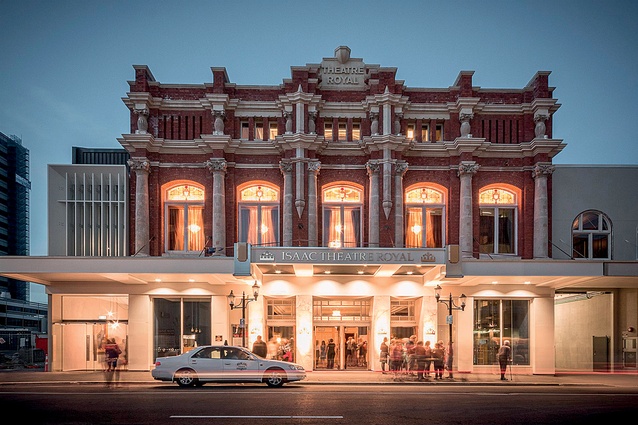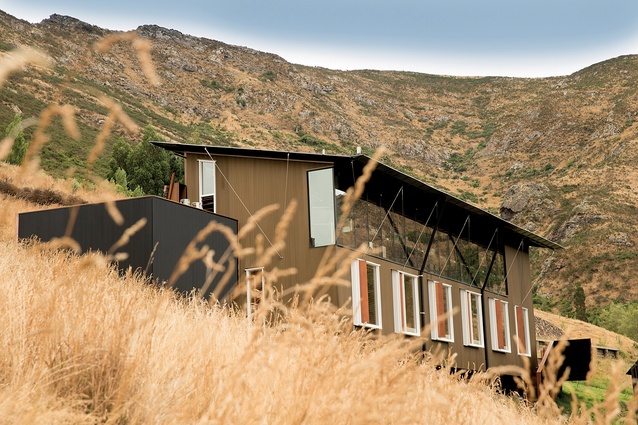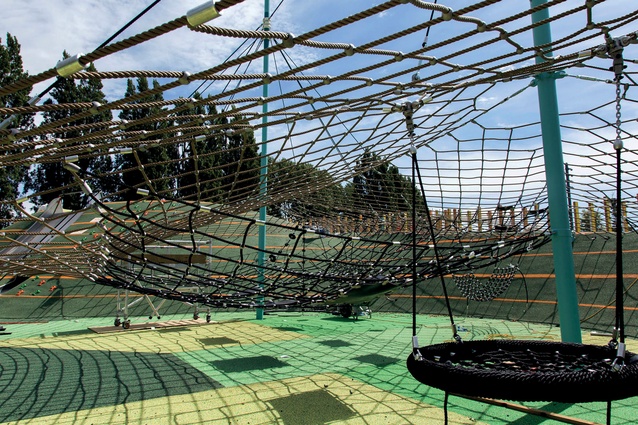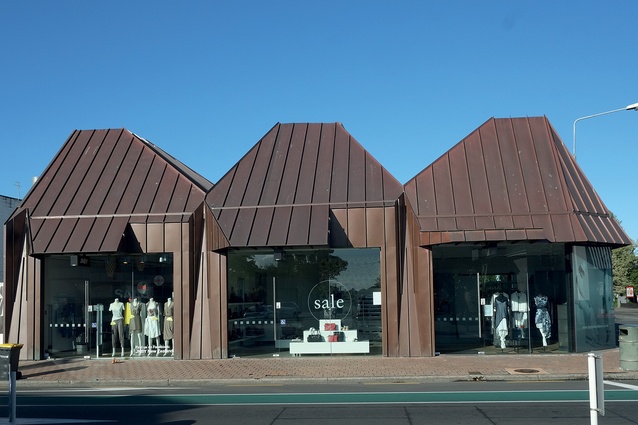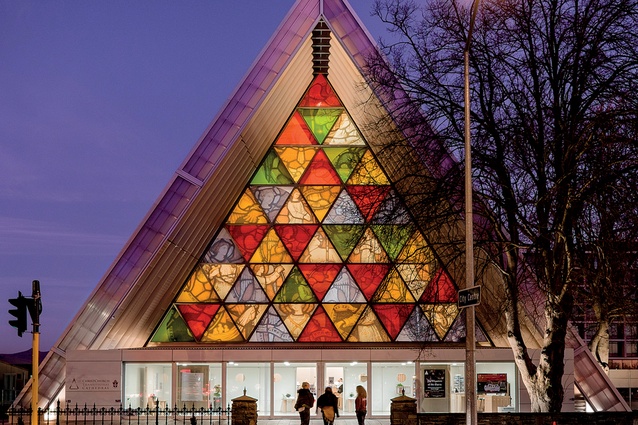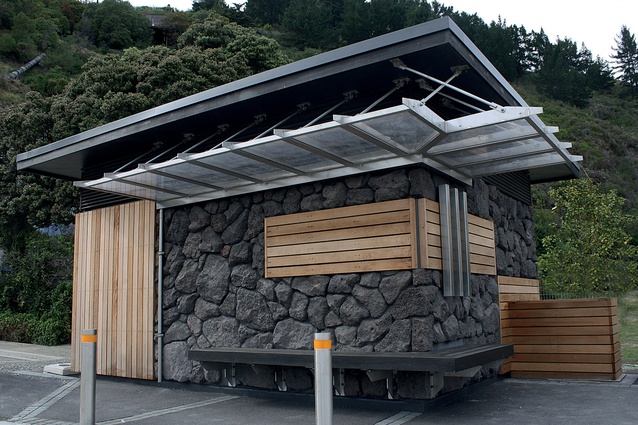Christchurch Five Years On – Part III
Five years after the Canterbury earthquakes, which devastated large swathes of Christchurch, Architecture New Zealand asked a selection of those involved in rebuilding the city to comment about progress made during what has been a period of tremendous change. This is the last in a series of three.
MONUMENTS OR MILLSTONES
Ross Gray is a Christchurch-based contemporary painter and teacher, who has been a campaigner for the retention of heritage buildings, particularly since the Canterbury earthquakes in 2010 and 2011. Gray is deputy chair of Historic Places Canterbury and was an organiser of the ‘Valuing Our Heritage’ information centre and exhibition at Shop 7, Cathedral Junction, presented by Historic Places Canterbury, Christchurch Civic Trust, IConIC and Restore Christchurch Cathedral.
The ground-breaking Christchurch City Council 2011 ‘Share an Idea’ campaign, which generated 106,000 community responses, expressed Cantabrians’ view that a future city which incorporated its past heritage was very important to them. Sadly, however, this has been largely thwarted by the actions of CERA, often in concert with reluctant owners of damaged heritage buildings, relieved to be rid of a perceived millstone. What should have controlled the heritage recovery progress – The Canterbury Earthquakes Heritage Recovery Programme produced by the Ministry for Culture and Heritage – finally appeared as government policy in November 2014, more than a little too late!

Thankfully, there have been some widely publicised and significant post-earthquake heritage rescues, including the massive in-progress restoration of the Arts Centre, the $40 million restoration of the Isaac Theatre Royal and Christchurch City Council’s $127.5 million restoration of the Town Hall, which is well under way.
But it’s probably not well-known nationally that around 250 listed heritage buildings – a truly shameful figure – have been demolished in Christchurch since the first earthquake in 2010. This very sad litany of loss featured as a 10m-long printout in ‘Valuing Our Heritage’ from late 2013 until late 2015: Manchester Courts, The Regent, the former Public Library, Cranmer Courts, Bishopscourt, the CPIT War Memorial Hall… the list goes on and on… much to the shock and disbelief of thousands of overseas, national and local visitors.* Visitors’ disbelief that the Anglican Church was intent on demolishing arguably the city’s most important heritage building, Christchurch Cathedral, was universal.
Many damaged heritage buildings, which could have been restored, succumbed to CERA’s power to issue Section 38 demolition orders, not only on its own initiative but also in response to the request by owners. Listed, apparently ‘protected’ buildings, although repairable, have thus been demolished to “expedite the recovery of the city in a timely manner”, bypassing the normally transparent RMA process. In spite of such haste, often-bare windswept land remains several years later, as with the former Railway Station on Moorhouse Avenue.
Regrettably, the CCDU Blueprint of 2012 has sacrificed several important interwar buildings for the rebuild, including the highly innovative former Millers Building (1939), which was demolished to make way for the Christchurch Bus Interchange [featured in the January issue of Architecture New Zealand] and the city’s first fully steel-framed building, the 1930 Majestic Theatre, demolished for the widening of Manchester Street.
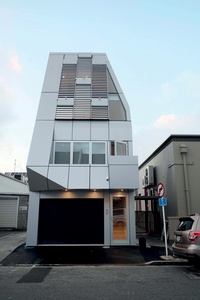
While many Cantabrians are still wary of masonry structures, their attitude to timber is very different. In mid-2013, when it was mooted that McLean’s Mansion** was to be demolished under a Section 38 notice, there was an outcry in the Stuff columns, with huge support for retention – because of its wooden construction and, set behind a veil of trees, its mystery and magnitude! This stunning twin-towered kauri structure of over 2,100 m2 is one of the nation’s largest wooden buildings.
Its idiosyncratic design is not to everyone’s taste but the story behind it – built between 1899 to 1900 for a 78-year-old bachelor, one of Canterbury’s wealthiest men, and, then, home for ‘women of refinement and education in reduced or straitened circumstances’, used as a dental nurses’ hostel and, since 1987, as an educational facility – has truly endeared it to Cantabrians in a unique way.
The current owners, having apparently exhausted retention possibilities, have put McLean’s Mansion on the market “as is, where is”. Many, including Historic Places Canterbury, are determined that this building, with such a remarkable past and such tremendous possibilities for the future, will not join the woeful roll of Christchurch heritage demolitions.
* The Canterbury Earthquake Heritage Demolitions website (created by Dr Lynne Lochhead, Secretary of Historic Places Canterbury) collates information about the heritage buildings which have been lost as a result of the Canterbury earthquakes of 2010 and 2011.
** The Architectural History of Christchurch 3. McLean’s Mansion, published by Christchurch City Council in June 1983, can be downloaded here.
CITYSCAPING
Hugh Nicholson, principal urban designer at Christchurch City Council, offers both a personal account and a summary of the city’s changing urban scape.
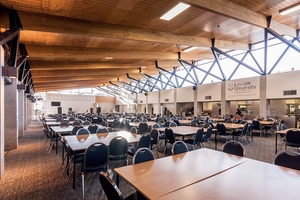
At TedxEQChCh in 2011, I talked about the grief of losing our city, of losing so many of our landmarks and treasured buildings, and about how our memories are inextricably entwined with the physical cityscape, the house where I grew up, the café where I had my first date, the cinema where I hung out with friends. And I spoke of the visceral shock of walking through the ‘red zone’ through shattered buildings and broken streets, of feeling dislocated, of looking into buildings where the walls had fallen down and seeing food and half-full cups of coffee on tables, of bags and possessions left lying like the detritus of a lost world. And the rawness of the huge demolition machinery smashing down our buildings.
In our worst-case scenarios, we never imagined that approximately 80 per cent of the buildings in the central-city core would be demolished or that 8,000 houses would be ‘red zoned’, bought by the Government and unable to be rebuilt. We have come to realise that there will be vacant spaces for decades and that recovery is a long-term game.
Five years on and there is a new feeling – there are half a dozen cranes wherever you look in the central city and new buildings seem to ‘spring’ out of the ground. One week, they are angular steel skeletons and, the next, they are clad in shining glass and aluminium, like spaceships sitting amongst the road works and traffic cones. In the centre, a new ‘low-rise’ city is taking shape, seven storeys and built to the street edge, with only a few of the original towers left standing like lone sentinels.
After the quakes, we debated whether Christchurch should follow Napier’s example and set an architectural style for the rebuild - we chose not to - recognising that every era develops its own style, shaped by a combination of economics, technology and culture. The Christchurch style becomes more obvious each day: lightweight steel and glass commercial buildings with exposed seismic engineering features, diagonal braces, base isolation trenches, and a seismic gap of more than half a metre between every building. And a plethora of aluminium fins and louvres, of all angles and sizes, shading and articulating, hiding and revealing.
Much of the centre of the city is being rebuilt to a kind of ‘corporate urbanism’ - large-scale commercial buildings with open floor plans. The corporate Catch 22 runs something like this - the landowner needs to borrow from the bank; the bank will only lend if there are confirmed tenants; the only tenants who can confirm their tenancy two years in advance and afford the high rentals are the larger corporates, ergo we build large-scale corporate buildings. Hopefully the ‘second wave’ of rebuilding will include finer-grained, small-scale buildings to fill the gaps.
Meanwhile, the Christchurch Hospital is undergoing a major rebuild project, with new acute services and outpatients’ facilities, under construction in the centre of the city; new specialist facilities at Burwood Hospital; and a series of new satellite facilities around the region.
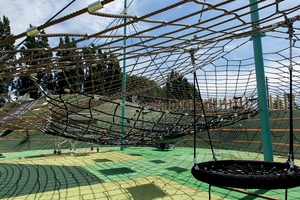
The Ministry of Education is building 13 new schools on new sites and rebuilding 10 new schools on existing sites, as well as carrying out extensive repairs to other schools around the region. The new Justice and Emergency Precinct – which will house the police, law courts and the civil defence agencies – is under construction.
The Christchurch Art Gallery and Theatre Royal have reopened, and the Arts Centre and the Town Hall are under repair. The new Bus Interchange and the Margaret Mahy Family Playground have opened, and the new Central Library and Metrosports facility are being designed and tendered. Eighty-five per cent of the infrastructure repairs around the city have been completed, even though roadworks are still a daily reality for many of us.
There are still many unanswered questions – Will the Cathedral be rebuilt? Will there be a new convention centre or stadium? What is the future of the red zone? But there is also a sense of progress, of moving forward – a sense of a new Christchurch waiting in the wings.
A CHAPTER IN HISTORY
Karen Sanderson, a principal of architecture at Beca, originally from Northern Ireland, has been immersed in designing and building infrastructure projects around Christchurch.
There is a generation of Kiwis who will all remember where they were when the 22 February 2011 earthquake struck Christchurch. Registering 6.3 on the Richter scale, it caused more widespread damage and devastating fatalities than the 7.1 quake that preceded it the previous September.
As an architect from Northern Ireland, living and working in Tauranga, I could empathise with the tragic circumstances in which Cantabrians now found themselves. Coping with loss, destruction and an uncertain future is a struggle that I saw and experienced when growing up near Belfast through the ‘Troubles’. I saw, then, how tragic circumstances can lead to opportunities to shape a modern, vibrant city. I also saw that the grief over loss of cherished buildings and landmarks could, in time, turn to an appreciation of well-designed, fit-for-purpose new buildings and spaces. I wanted to help.
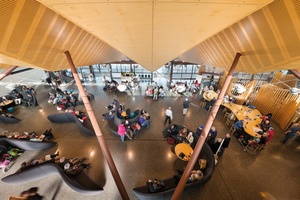
With the support of my practice, I relocated to Christchurch, initially living on the edge of the ‘red zone’ cordon that had been erected around the CBD. I remember vividly the eerie feeling I had when walking up to the steel barrier on my first night there and gazing into the darkness beyond. I wondered what lay within, what had been lost, what the future might hold, and how long it would take to realise a new future. I felt the sadness the memories evoked but, also, excitement at what the city might become.
It would be more than two years before the cordon was lifted and I could enter, for the first time, the CBD of the city I had come to call home. In 2012, the Blueprint was released with its aspirations for a ‘Vibrant, Green, Prosperous and Accessible City’. It was an exciting time to be an architect in Christchurch and there was an expectation that a deluge of work would arrive, offering opportunities for dynamic and meaningful design projects.
The reality was different. Progress with many developments was slow as insurance battles ensued and it was some time before we saw demolition decisions made and implemented to the point of allowing the CBD to open (1,100 buildings were demolished in the city centre). Initially, my work involved assisting with assessment of damaged buildings and then working with clients through rebuild options. It felt like a long time was spent on projects on the drawing board before we saw the reality of construction. The business environment was competitive as professionals from around the world responded to the ‘call for arms’ and saw an opportunity for work.
A key priority was the rebuild of the city’s horizontal infrastructure. Along with 1.6 million square metres of road, more than 600km of Christchurch’s sewer pipes and 70km of water mains were damaged. The Stronger Christchurch Infrastructure Rebuild Team (SCIRT) was the alliance established to address this. The SCIRT team was mobilised quickly and included designers from various disciplines and from a range of consultancies. The feeling of a shared mission was powerful. I was fortunate to work with a small team of landscape architects and urban designers who were passionate about adding value to these critical infrastructure projects.
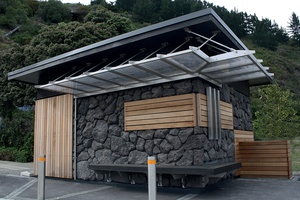
While acknowledging the priority of function and resilience, we campaigned to demonstrate to our government client, and our fellow engineering designers, how integrating architecture could enhance outcomes for the community and create a legacy of which to be proud. We established guiding principles for our work and believed that every project, however small or utilitarian, should respond to its context and add amenity.
An example of our success in meeting our aims is a new vacuum station in the eastern suburbs, adjacent to a large busy, retail centre. We worked with the engineers to reorganise the site, including the underground chambers and pipework, to allow the building to be set back, more in line with neighbouring residential property. This then allowed us to create a ‘pod park’ and give back some land to public realm.
Owing to the 100-year resilience requirement, all of the pump station buildings are constructed of concrete. However, we treated the façades with detail and materiality, to be sympathetic with the residential context. The landscape designs were integrated with the architecture and the outcome is a successful space that offers something to the local community who live alongside the facility on a daily basis.
This experience has led me to become a firm believer in the immense value that small interventions can have in our urban fabric and the importance of good design at local community level. The huge response to the Christchurch City Council ‘Share an idea’ campaign demonstrated how the city’s residents care about their environment, and want to be involved in the conversation around its design.
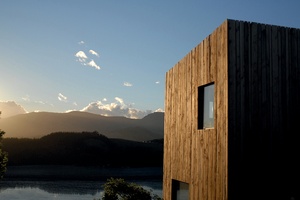
Like the vibrancy that the Gap Filler projects brought to post-quake Christchurch, there can be a whole that is greater than the sum of the parts if we approach everything as an opportunity to integrate design and create the high-quality environment we want to live in. Whether it is a utility building, a road or the anchor projects – there is a role for the architect to ask themselves (and their clients!) how it can be made special for the people who will live, work and play alongside it.
Five years on, Christchurch is now growing upwards. There is life returning to the city centre and building projects are being completed on a monthly basis. For us in the industry, it is exciting to see the cranes and new technologies as one huge construction showcase in which we are living. The eerie silence of the blackened hole in the post-quake central city is now filled with noise and vibrancy as the damage and destruction is replaced with the new and complete.
It is only when I visit another city that I remember the ‘normal’ I live with in Christchurch is really still quite far from being a properly functioning city, and that the miles of road cones and containers as protective barriers will still be here for some years to come. For now, these serve as footprints of the past events that led us here. I wonder, in another five or even 50 years, how the city’s memories will be retained.
Five years ago, I felt that Christchurch would provide a unique opportunity to use my professional skills to help with the rebuild of the city. Today, I feel privileged to have been a part of a chapter in history.
You can find the first installation of commentary here, and the second here.

